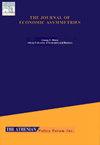撒哈拉以南非洲国家公共债务与通货膨胀之间的因果关系
Q1 Economics, Econometrics and Finance
引用次数: 0
摘要
本研究旨在调查和比较1990年至2021年期间14个撒哈拉以南非洲国家公共债务与通货膨胀之间的对称和非对称因果关系。它还审查了国家政策和机构评估(CPIA)得分的趋势,特别是在债务政策和收入调动效率领域。该分析采用了Konya(2006)的对称引导面板因果检验和Yılancı和Aydın(2017)开发的不对称方法,该方法基于Granger和Yoon(2002)以及Konya的方法。结果显示出显著的非线性和相当大的跨国变化。在对称规范下,从公共债务到通货膨胀的因果关系只存在于四个国家。然而,如果考虑到不对称性,这个数字就会增加到12。同样,虽然使用对称模型在四个国家观察到通货膨胀与债务之间的因果关系,但不对称框架在11个国家显示了证据。这些发现通过提供债务与通胀关系的比较视角,为文献做出了贡献。此外,结果表明横断面依赖性在整个小组中存在,并证实了国家特异性异质性。对CPIA指标的分析还指出,整个地区在公共债务管理和收入动员方面的机构能力水平各不相同。值得注意的是,肯尼亚在收入动员方面的最佳表现表明,健全的制度框架可以增强公共债务水平上升与通胀之间的预测关系。这项研究的发现对撒哈拉以南非洲的财政和货币政策具有重要意义。本文章由计算机程序翻译,如有差异,请以英文原文为准。
Causal links between public debt and inflation in sub-Saharan African countries
This study aims to investigate and compare both symmetric and asymmetric causal relationships between public debt and inflation across a panel of 14 sub-Saharan African countries over the period 1990 to 2021. It also examines trends in Country Policy and Institutional Assessment (CPIA) scores, particularly in the domains of debt policy and the efficiency of revenue mobilization. The analysis employs Konya's (2006) symmetric bootstrap panel causality test and an asymmetric approach developed by Yılancı and Aydın (2017), which builds on Granger and Yoon (2002) and Konya's methodology. The results reveal notable nonlinearity and considerable cross-country variation. Under the symmetric specification, causality from public debt to inflation is found in only four countries. However, when asymmetry is incorporated, this number increases to twelve. Similarly, while causality from inflation to debt is observed in four countries using the symmetric model, the asymmetric framework reveals evidence in eleven countries. These findings contribute to literature by offering a comparative perspective on the debt-inflation nexus. Moreover, the results indicate the presence of cross-sectional dependence across the panel and confirm country-specific heterogeneity. The analysis of CPIA indicators also points to varied levels of institutional capacity in public debt management and revenue mobilization across the region. Notably, Kenya's top performance in revenue mobilisation suggests that robust institutional frameworks can enhance the predictive relationship between increase public debt levels and inflation. The study's findings carry significant implications for fiscal and monetary policy in sub-Saharan Africa.
求助全文
通过发布文献求助,成功后即可免费获取论文全文。
去求助
来源期刊

Journal of Economic Asymmetries
Economics, Econometrics and Finance-Economics, Econometrics and Finance (all)
CiteScore
4.80
自引率
0.00%
发文量
42
审稿时长
50 days
 求助内容:
求助内容: 应助结果提醒方式:
应助结果提醒方式:


